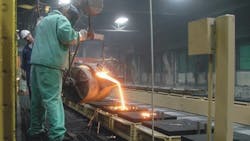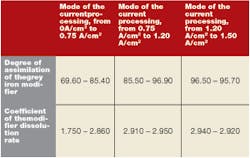Factors Influencing Electric Field Treatment for Alloy Modification
Improving the mechanical properties and increasing the stability of alloy modification processes are very important aspects of metalcasting: It makes it possible to reduce the wall thickness of cast products. One way to enhance the results of the alloy modification process is electric field treatment of the liquid metal with particles of a modifier introduced therein.
The total energy for a thermodynamic system of the molten metal Eme is equal to the sum of the internal energy E1 of the whole physical object (system) and the external energy, which includes the kinetic energy E2 of the object and the potential energy E3 of the particles of the object under the external force fields, i.e.:The energy E1 includes all forms of energy, which the object in question (the total volume of the molten alloy) possesses, and this energy for a particular process at given optimal temperature of the modified alloy can be considered as constant. The amount of energy E2 of a given object at rest is equal to zero. The value E3 varies depending on the presence and magnitude of the external force field.
In the presence of an electric field acting on the molten metal, the energy E3 is spent on:
- Interaction of the atoms of the molten metal with current carriers accelerated by the electric field;
- Impact of current carriers available in liquid alloy on crystallization centers;
- Interaction between elements of crystal alloy emerging under the influence of modifier.
The last term in this equation, which is the energy of an electric current, can be set equal to zero if the frequency of current is standard for plants.
The first term in this equation, which is the energy of the current, describes the loss of energy due to heating, which occurs in the conductor due to the Joule-Lenz law. The second term is equal to energy change of the electromagnetic field in time and occurs when a current is passed through the wire, which is the metal melt.
It should be noted that the magnitude of the electromagnetic field is small, if we use the method of conductive current supply, and therefore its effect on the molten metal can be ignored.
Hence, the major factor affecting the electric current in this processing method is the energy dissipated in the conductor by the Joule –Lenz law. In the case of electric current flow passing through the liquid alloy, this energy is released in the local volume of the melt located in the inter-electrode space, causing an intensification of convective flows in the whole volume of the liquid alloy, which improves the conditions of mass transfer of chemical elements from dissolving modifier particles to the molten metal.
As shown by the results of experiments for the process of modifying gray iron, with σv = 250 MPa, the values of the degree of assimilation for silicon-bearing inoculant (Si = 75.0%), and values of the coefficients of dissolution rate of a modifier obtained by "solid-liquid" contacts, may vary significantly. This change depends on the range of the melt processing conditions by the electric current during inoculation (see results in Table 1.)
The growth rate of dissolution of the particles in the liquid inoculant alloy increases the level of alloy absorption of a modifier and makes it possible to reduce the percentage of an input modifier in the absence of requirements to increase the strength of the modified alloy.
Growth of the energy of the liquid alloy Eme by increasing the value of E3 facilitates the process of overcoming the energy barrier of alloy crystallization, related to the occurrence of the elements of alloy crystals.
Evaluating in Reduction in Mechanical Properties
Previous industrial experience applying this method to alloy processing with modification showed a significant increase in the mechanical properties of gray iron (σv = 250 MPa), the modified silicon-bearing inoculant (Si = 75.0%), while the percentage of input is 0.7% by weight of iron, on average, from 253.0 MPa to 294.0 MPa. In this case the value of the standard deviation of the strength limit of iron decreased from 9,670 to 5,430 MPa, showing the increased stability of the results of the process of modifying the alloy.
Processing electrically treated steel (C = 0.4%) in the process of modifying ferrotitanium (Ti = 20.0%), in an amount of 0.5% by weight of steel, leads to an increase in strength properties (σv) averaging 532.0 MPa to 566.0 MPa, and plastic properties (σt) from 311.0 MPa to 333.0 MPa. Thus, there is a reduction in the standard deviation values of the mechanical properties of modified steel.
If we consider the process of modifying alloys, taking into account the earlier study1, it can be split into the following steps:
- Enter the modifier particles in the molten metal;
- "Freezing off" the modifier of the alloy layer on the relatively cold particles;
- Melting of the particles of the “frozen” crust using the thermal energy of the alloy;
- The beginning of the dissolution process of the particles of modifier in the molten alloy;
- The transfer of chemicals of modifier by diffusion processes in local volumes of the molten metal;
- The end of the dissolution process for modifier particles in molten metal and attaining a certain degree of assimilation of chemical substances of modifier by the melt;
- Elements of alloy crystals rising under the influence of modifying additives;
- The distribution of the solute modifier throughout the volume of the molten alloy;
- The beginning of the process of "decreasing" of the modifying effect;
- The end of the process of "decreasing" of the modifying effect.
For a high-performance effect of the electric field, the duration of the exposure process is especially important, starting with introduction of the modifier particles to the molten metal, and ending with the process of "decreasing" the modifying effect. Shorter or longer processing periods, in terms of beginning and end of the treatment, will reduce the positive effect of the electric current in the alloy modification.
This is because short processing does not provide sufficient energy to effect alloy modification. With longer treatment the occurrence of rapid convective diffusion intensifies the mass transfer of the metal in the molten alloy, and averages the chemical composition of it throughout the volume. Such an accelerated homogenization of the melt worsens the conditions of nucleation under the influence of a modifier in micro volumes of alloy. And, for example, in gray iron treated with the silicone modifier, the area occupied by the inclusions of graphite reduces from an average of 13.0% to 11.0%, and the number of eutectic grains reduces from 163.0 to 126.0 per 1cm2 of the section alloy.
Consequently, the use of exposure to electrical and other physical fields in the process of modifying casting alloys has its own characteristics[2], which must be taken into account in a real industrial activity.
Thus, the growth of Eme of alloy when an electric field is applied to it leads to a change in status of the molten alloy. This change in status should be considered as a multi-factorial process: The main factors include energy force interaction, accelerated by the electric field current carriers with centers, and elements of alloy crystals formed when modifier particles are administered; and the intensification of convective flows in molten metal under the influence of Joule heat.
Convective diffusion leads to accelerated dissolution of modifier particles and increases its assimilation in alloy. Improving the conditions of crystallization of the alloy under optimal processing parameters associated with the stages of the process of modification improves the mechanical properties of casting alloys.
Dr. Minenko is an associate professor and head of the Resource Center for the Ministry of Industrial Engineering Education, Moscow. Contact him at [email protected]
REFERENCES
1. Polak, I. “Das Studium des Mechanismus und der Kinetik des Impfmittelauflösens im Eisen und seine Anwendung bei Formimpfung,” 44 Congresso Internazionale Fonderia, 1977, No. 2, 21-30.
2. Minenko G.N. “Influence of physical fields on secondary metallurgy of cast alloys “. Saarbrucken, Lambert Academic Publishing, 2013, p.108.
About the Author
G. N. Minenko, Ph.D.
Associate Professor and Head of the Resource Center of Mechanical Engineering
Georgy Nikolaevich Minenko, born 1946, Ph.D. in Technical Sciences, Associate Professor, Head of Resource Center of the Mechanical Engineering Branch of the Ministry of Education of the Moscow region.



